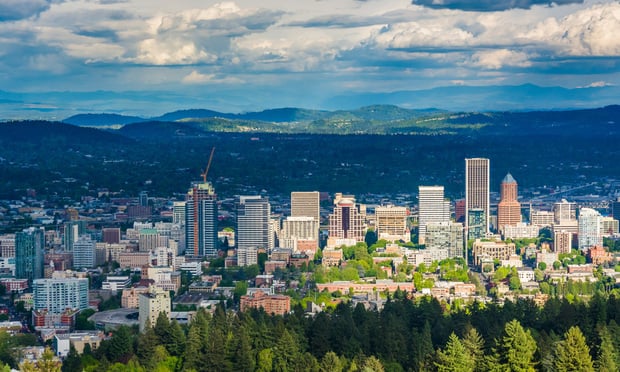 The Portland region is unique in its ability to bring in young, skilled households.
The Portland region is unique in its ability to bring in young, skilled households.
PORTLAND, OR—Portland is a fast-growing metro with a stable economy and high quality of life although like many West Coast cities, it has housing supply and affordability issues, according to Oregon Office of Economic Analysis. Its growth industries are apparel and design, food and beverage, and semiconductors. More broadly, strengths include renewable energy, wood products and UAVs.
Not to be outdone, e-commerce and health are factors, as Hillsboro-based Nike dominates the landscape. In addition, Oregon Health and Science is expanding its South Waterfront Campus, and Amazon has announced facilities in Troutdale, Salem and Hillsboro, with a combined 3,500 workers employed in those facilities. It is no wonder then, that Portland is attracting better-educated talent.
The region is unique in its ability to bring in young, skilled households, ranking above higher-paying metros with a major research university. It is outperforming older peers, but has not yet caught the nation's upper-economic tier.
Stats from the Bureau of Economic Analysis, Bureau of Labor Statistics, the Census Bureau and the Oregon Office of Economic Analysis show high-wage jobs have led the Portland economic expansion both in growth rates and in the absolute number of jobs added. When looking at Portland's ranking among the nation's 100 largest metros, there were 222,500 high-wage jobs in 2007, where Portland ranked 32nd in highest share. In 2016, that number shot to 301,100, giving Portland the 15th highest position, a 35% change or the fifth-fastest growth area.
In educational attainment or share of those aged 25 to 64 with a college degree, Portland had 34.1% in 2007, or the 27th highest. By 2016, that number had increased to 40.2% or 16th highest. This was a change of 6.1% or the fifth largest. This percentage increase in educational attainment is more than twice the gains in the typical metro. Portland now ranks the 16th highest for the share of 25 to 64 year olds with a college degree. Denver ranks 10th highest at 43.3% and Seattle ranks eleventh highest at 43.2%, slightly eclipsing Portland's 40.1%.
The previous Office of Economic Analysis work shows Portland's ability to attract young college graduates. Historically, Portland has had more arts and humanities degrees but in recent years, migration has shifted toward technical, scientific and medical degrees, which is reflective of the influx of Amazon, Nike, and Oregon Health and Science facilities springing up.
In terms of median household income, Portland income was $63,200 or 32nd highest. In 2016, that number increased to $68,700 or 19th highest, an 8.7% increase in the ensuing 11 years or fourth-largest change (inflation-adjusted 2016).
Portland incomes are nearly 9% higher today than before the Great Recession while the typical large metro has yet to recover. Portland has jumped from 32nd highest to 19th highest among the 100 largest metros. The city has pulled away from many of its former peers and has caught and/or surpassed large metros such as Atlanta, Chicago, and Los Angeles.
These gains in recent years are largely about an improving, stronger economy, pulling more households out of the bottom tier. More people are working, especially full time. In fact, the growth in 2016 was driven the most by a big shift into full-time employment. Earnings for workers are up as well. Portland has significantly more higher-income households today than the last decade.
With that being said, there is no evidence of lower-income households moving away from the region, even if pushed toward the fringes. This diverse industrial structure and strong pipeline of talent suggests good growth moving forward, which is not expected to change but would be a huge problem if it does, cautions the economic analysis office.
Nonetheless, Portland is undergoing transformational changes. Portland is not the only metro to undergo such changes in the past decade, but Portland's changes are among the largest.
This has resulted in some searching for the “next Portland”. However, each metro contender fails to measure up in at least one important way. None have both strong population growth and strong net migration among college-age and root-setting populations, a huge advantage, says the report.
While the economic and population growth rates are slowing today as the business cycle matures, the
region retains high quality of life and strong regional economy. If maintained, there will be a long-term advantage of net migration among young, skilled households, or some 35% within the first-time buyer pool, according to the Scotsman Guide. One glaring factor is affordability and adequate housing supply, the biggest threats.
“Multifamily is in the final innings and Millennials are being priced out of housing,” Roger Milstein of RWM Consulting LLC tells GlobeSt.com. “There is nothing under $350,000, as most single-family homes are in the $450,000 to $600,000 range.”
Recessions can reorient or restructure a regional economy, altering growth paths. Some industries fall back while others step forward. Portland's foundation, based on the income and education stats, seems on solid footing and can likely overcome the housing shortfall.
© Touchpoint Markets, All Rights Reserved. Request academic re-use from www.copyright.com. All other uses, submit a request to [email protected]. For more inforrmation visit Asset & Logo Licensing.







